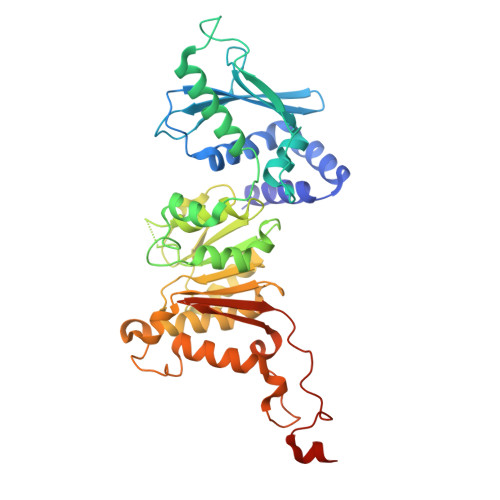Structural and computational insights into the regioselectivity of SpnK involved in rhamnose methylation of spinosyn.
Huang, S., Ji, H., Zheng, J.(2023) Int J Biol Macromol 253: 126763-126763
- PubMed: 37703985
- DOI: https://doi.org/10.1016/j.ijbiomac.2023.126763
- Primary Citation of Related Structures:
8IA9, 8IAA - PubMed Abstract:
Rhamnose methylation of spinosyn critical for insecticidal activity is orchestrated by substrate specificity of three S-adenosyl-L-methionine (SAM) dependent methyltransferases (MTs). Previous in vitro enzymatic assays indicate that 3'-O-MT SpnK accepts the rhamnosylated aglycone (RAGL) and 2'-O-methylated RAGL as substrates, but does not tolerate the presence of a methoxy moiety at the O-4' position of the rhamnose unit. Here we solved the crystal structures of apo and ligand-bound SpnK, and used molecular dynamic (MD) simulations to decipher the molecular basis of substrate specificity. SpnK assembles into a tetramer, with each set of three monomers forming an integrated substrate binding pocket. The MD simulations of SpnK complexed with RAGL or 2'-O-methylated RAGL revealed that the 4'-hydroxyl of the rhamnose unit formed a hydrogen bond with a conserved Asp299 of the catalytic center, which is disrupted in structures of SpnK complexed with 4'-O-methylated RAGL or 2',4'-di-O-methylated RAGL. Comparison with SpnI methylating the C2'-hydroxyl of RAGL reveals a correlation between a DLQT/DLWT motif and the selectivity of rhamnose O-MTs. Together, our structural and computational results revealed the structural basis of substrate specificity of rhamnose O-MTs and would potentially help the engineering of spinosyn derivatives.
Organizational Affiliation:
State Key Laboratory of Microbial Metabolism, School of Life Sciences and Biotechnology, Shanghai Jiao Tong University, Shanghai 200240, China.



















